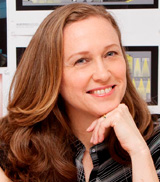Meet Our Member
The IESNYC spotlights a member each month whose volunteerism, perspectives or personal story helps advance our goals, pique our curiosity, and whose contributions help the IESNYC become a more vibrant and diverse lighting community. We value their expertise and thank them for volunteering their time and energy for the betterment of the section and NYC Lighting Community. #the_iesnycmom
August 2023
 Melanie Freundlich
Melanie Freundlich
Principal, Melanie Freundlich Lighting Design
Q: How did you first get started in the lighting industry?
I was a theater major in college with an emphasis on production. The first time I ran a followspot I was hooked! There was virtually no set, so the lighting provided all the context and emotion! My senior thesis was to light and stage-manage the senior dance performance: more than 15 individual pieces that involved cutting piles of gels to be switched out at each boom stand 15 times.
My first job was Assistant Company Manager for The Boston Ballet, with most of my time spent touring New England as a tech director and lighting designer for the apprentice company. During my years as the company manager and lighting designer for Dinosaur Dance Company (also in Boston), I designed and managed a multi-purpose performing arts space for their use and as a rental venue.
This experience designing a semi-permanent theatrical venue started me thinking about lighting in the built environment – as something set in stone versus a design you disassemble every 6 weeks. I didn’t meet any women who were theater consultants at that time, but theatrical lighting designer Jean Rosenthal wrote a book that I read and re-read. She was the only person who looked like me in theater lighting.
Returning to New York in the mid-eighties, I initially took a position as a theater consultant with Artec Consultants. They didn’t quite know what to do with me, so I started as an assistant doing space programming. We worked with a variety of consultants on space planning at performance centers, but I missed designing with light. With some architectural language and process under my belt, I continued to develop an interest in architectural lighting design and began my MFA studies at Parsons.
Later, when I joined Fisher Marantz Renfro Stone, I was often back to being the only woman in the room. But I was quickly involved in an amazing roster of projects and felt I’d found my niche! I learned a lot from Paul Marantz, and moved up. Several women from that FMRS “class” have been quite successful. Susan Brady, Teal Brogden, and I are all partners or business founders. Along with a number of designers from other large firms of that time, we have supported each other over the years. I feel like between Parsons and my 10 years at FRMS, I gained a solid architectural lighting design skillset.
When I had my first child, I became a part-time consultant to FRMS. And when my second child came in 1997, I hung out my shingle as MFLD.
Q: How do you see the role of the IESNYC?
I joined the IES during the 3 years I attended Parsons, where I constantly referred to my thick IESNA Lighting Handbook for engineering standards and methods. At FMRS we used it for daylight studies, basic lighting applications, roadway luminaires, and all the other technical components of a project’s program brief. This was in 1987, when you couldn’t go to the internet for quick lighting facts and data. And calculation programs like Lumen Micro were in their infancy! A lot of manufacturers had no photometric files available, even on disk, so we were frequently modifying the IES standard-fixture files.
My “role” as a member is really to take advantage of the IESNYC networking and programs available to me as a small business owner, design principal, and member of the broader lighting community. I have often networked through IESNYC to discover young talent, and have enjoyed the privilege of mentoring a number of women who have interned or worked for me over the years.
I’ve been a member for more than 25 years, but recently the Lumen Awards have become very important. I’ve gotten involved as both a judge and an award winner. For a small firm, winning a Lumen brings great PR: media exposure we don’t often see. Adrienne Shulman and Clara Powell have been terrific assets to the Lumen program, and I so appreciate their encouragement over the years.
Q: In your opinion, what are the best assets of the IESNYC?
I continue to read up on new research and technical developments, and I am able to stay in touch with NYC manufacturers, agencies, and engineers while attending webinars, meetings, and awards dinners. The Section also provides an arena for the many members of the architectural community to gather resources to serve the public sector. Great public lighting enriches communities across the NYC Metro area. Thanks in no small part to the diverse talent pool nurtured and educated by the IESNYC.
2025 IESNYC Event and Educational Sponsors
Brilliant Sponsors
Radiant Sponsors
Glow Sponsors
Sparkle Sponsor
Twinkle Sponsors
Available Light | Hartranft Lighting Design | HLB Lighting Design
